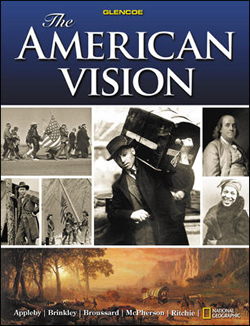
The American Vision © 2008Chapter 2: The American RevolutionChapter OverviewsThe Colonies Fight for Their Rights Section 1 examines how Britain's tightening controls created tensions in the American colonies. Victory in the French and Indian War left Britain deeply in debt. British leaders, who thought the colonies should help repay the war debt, levied new taxes and issued new regulations designed to maintain British authority in the colonies. Angry colonists united in their opposition to the controls and formed patriotic groups such as the Sons of Liberty and the Daughters of Liberty. Colonists protested with pamphlets, demonstrations, boycotts, and even violence. Objecting to the Stamp Act, representatives from nine colonies filed a declaration stating that only colonists' political representatives had the right to tax them. Their protests forced British lawmakers to repeal the Stamp Act, but Parliament retaliated by reasserting its right to make laws for the colonies. The Townshend Acts, another series of regulations and taxes, soon followed. Colonial resistance and increasing violence finally forced Britain to repeal the Townshend duties, except for the tax on tea. The Revolution Begins Section 2 details the series of events that led to the issuing of the Declaration of Independence. Even though the colonies enjoyed two years of peace, British policies continued to undermine colonial freedoms. Colonists formed committees of correspondence to communicate with one another about British activities. After the Boston Tea Party, Parliament passed the Coercive Acts to punish Massachusetts. In response, colonists formed the First Continental Congress and organized a boycott of British goods. Continuing to defy Britain, Massachusetts created a provincial congress and militia. British control weakened as other colonies did the same. In April 1775, battles at Lexington and Concord signaled the start of the war. A few weeks later the Second Continental Congress met and formed the Continental Army. Meanwhile, Thomas Paine’s pamphlet Common Sense convinced many colonists that the time had come to declare independence. On July 4, 1776, the Continental Congress issued the Declaration of Independence. The War for Independence Section 3 explores the strategies and battles of the Revolutionary War. George Washington's inexperienced, poorly-equipped band of soldiers seemed no match for the confident, well-trained British Army. The British plan to separate the New England states from the Southern states was hampered by their army's slow movement and their generals' failure to coordinate strategies. They successfully captured some important cities and kept Washington's troops on the move, but the British failed to surround American positions. Although the bitter winter of 1777 devastated the Continental Army, an important victory at Saratoga, New York, lifted Patriots' spirits and convinced France to send troops. Americans used surprise tactics and a stealthy militia to their advantage during the long struggle. The British economy suffered as Americans attacked British merchant ships. In 1781 Washington and his troops, supported by French troops and the French navy, surrounded the British at Yorktown, Virginia, and secured the British surrender. The War Changes American Society Section 4 describes how the war changed American society. When the colonists severed ties with Britain, they established a republic—a form of government where power resides with a body of citizens entitled to vote. John Adams favored a separation of government powers and the division of the legislature into two houses—the senate and the assembly. Many states wrote new constitutions based on his ideas. States also attached lists of individuals' rights to their constitutions. Changes in American society reflected a key component of a republic—the idea that all citizens are equal under law. It became easier for white men to gain the right to vote, governments separated themselves from churches, and women made some social gains. While thousands of enslaved African Americans gained their freedom during the Revolution, Loyalists found they had lost their position in American society. Americans began to build a national identity reinforced by patriotic symbols, folklore, and art. |  |















